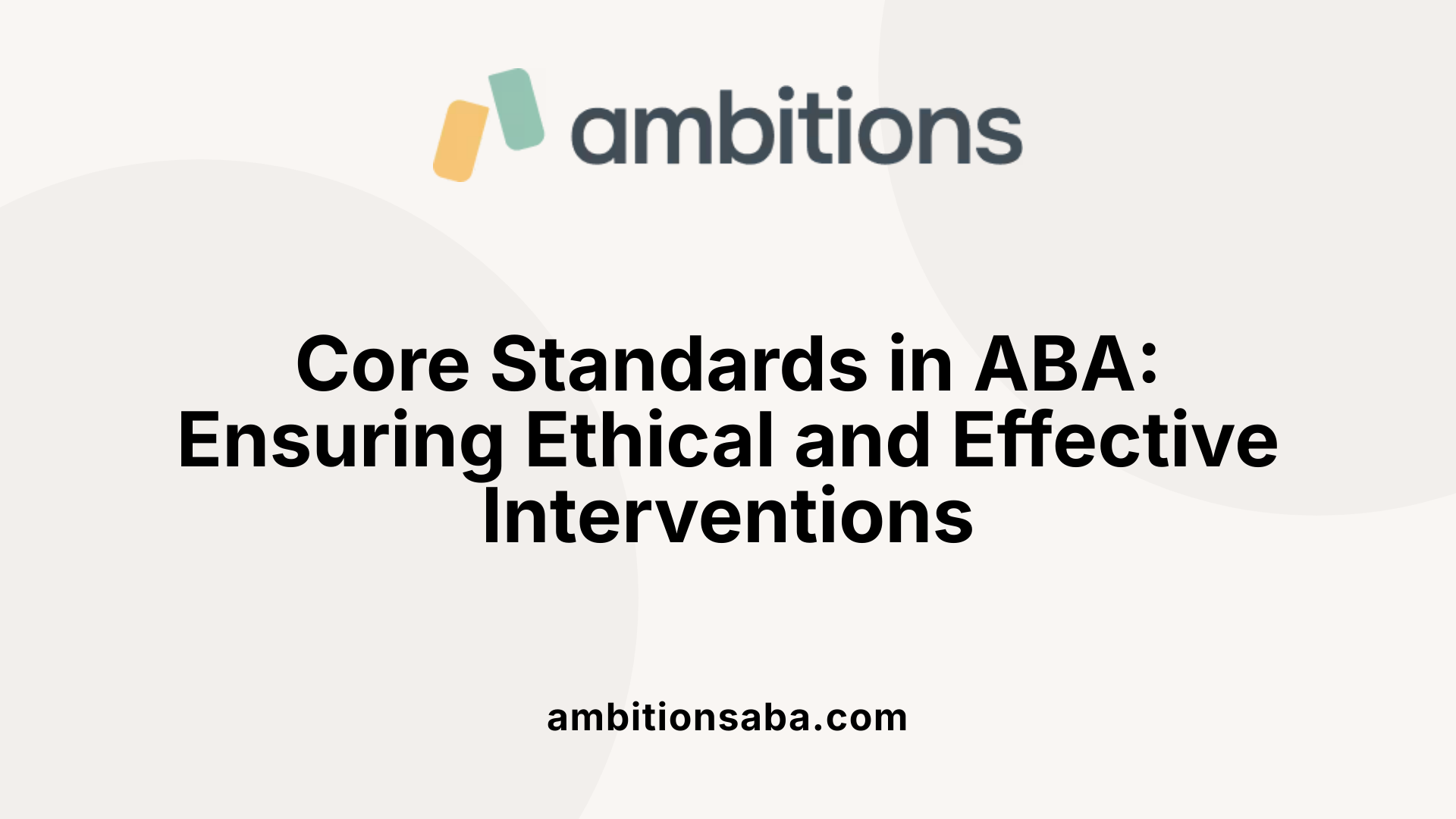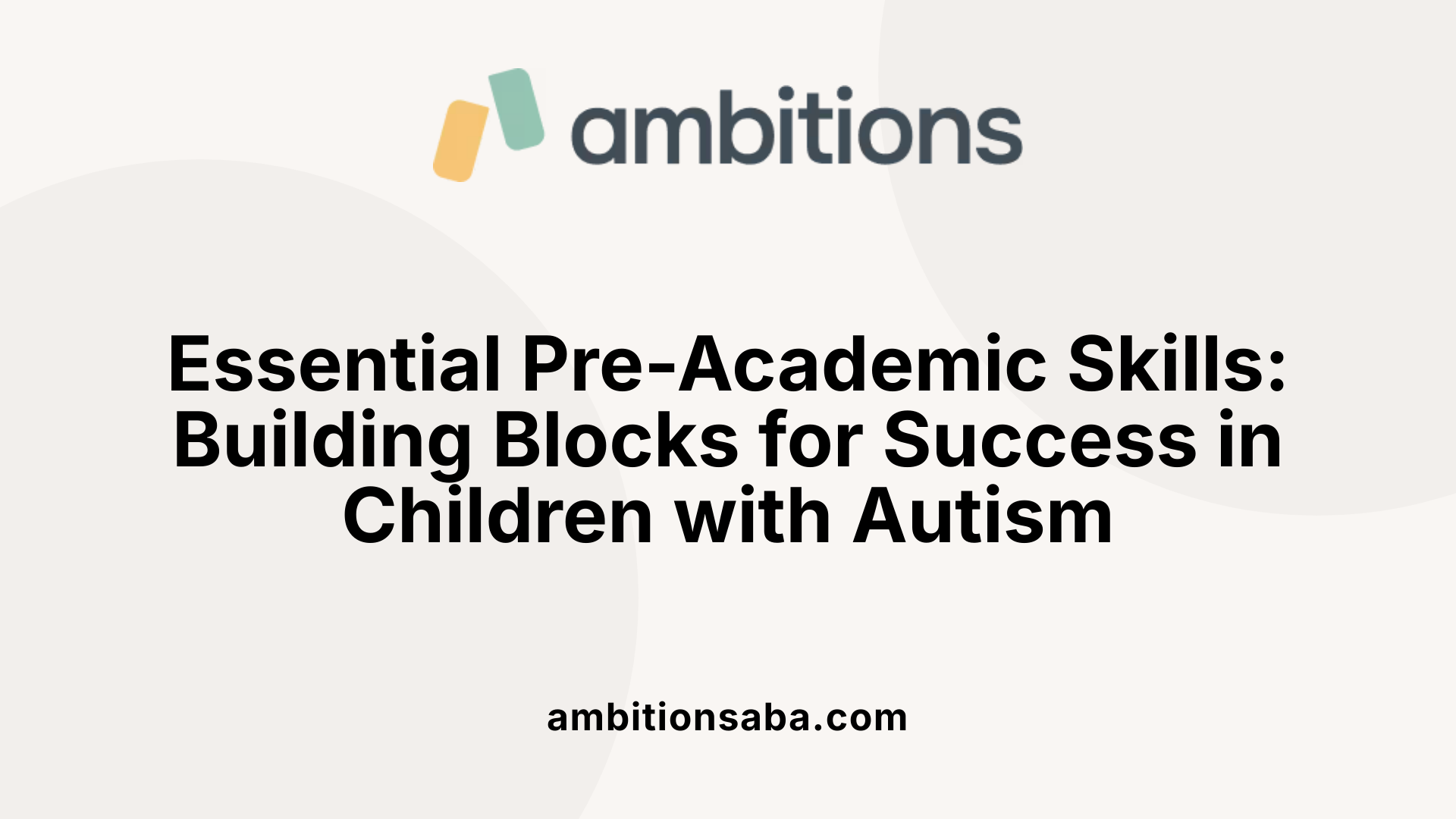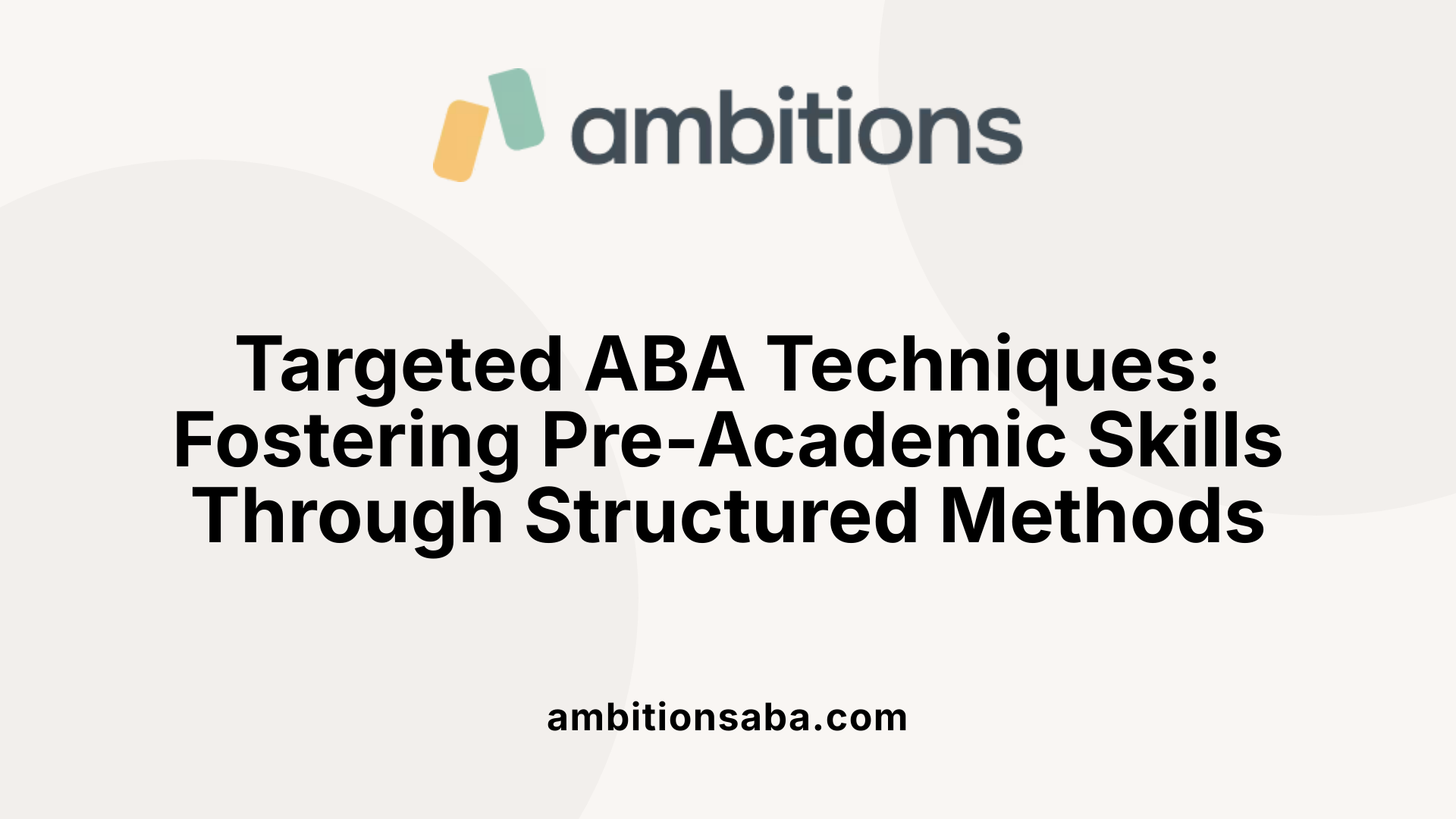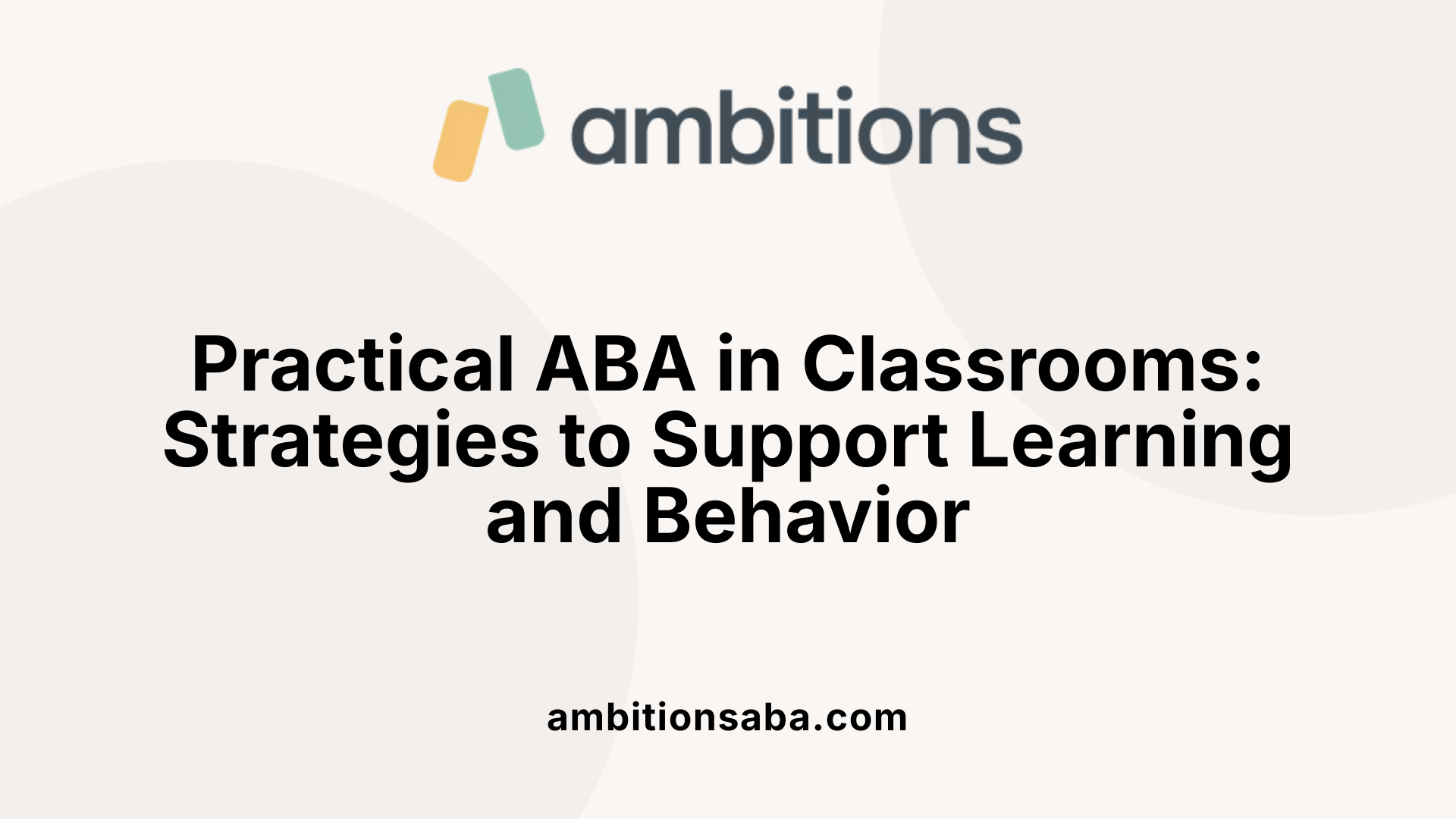Empowering Calm: Strategies to Support Self-Soothing in Challenging Moments
The Role of ABA in Developing Pre-Academic Skills for Children with Autism
Applied Behavior Analysis (ABA) has emerged as a cornerstone in teaching pre-academic skills, particularly for children with autism. Its scientifically supported strategies not only foster foundational abilities like communication and social interaction but also prepare children for school success. This article explores how ABA methodologies are effectively used in early childhood education, emphasizing individualized interventions, parent and educator collaboration, and evidence-based practices to support developmental progress.
Overview of ABA and Its Foundations in Education

What are the principles of behavior analysis?
Behavior analysis principles, established by Baer, Wolf, and Risley in 1968, serve as the foundation for applied behavior analysis (ABA). These principles include being analytic, technological, and conceptually systematic. Being analytic means thoroughly understanding the relationship between behaviors and their antecedents and consequences. Technological refers to the clarity and replicability of intervention procedures, ensuring that all steps are well-documented. Conceptually systematic indicates that interventions are grounded in behavioral theory, maintaining consistency with scientific principles.
ABA emphasizes positive reinforcement, data-driven decision-making, and systematic intervention strategies. These core standards promote effective and ethical practices in behavior modification and learning support.
What is the role of ABA in teaching pre-academic skills?
Applied Behavior Analysis (ABA) is central to teaching pre-academic skills, especially for children with autism. It helps develop foundational abilities like communication, social interaction, attention, self-regulation, and basic academic skills such as literacy and numeracy.
ABA uses individualized plans that break down complex skills into small, manageable steps through task analysis. Techniques like positive reinforcement and prompting support skill acquisition, while naturalistic teaching methods encourage generalization to real-world settings. Early and intensive ABA interventions have shown remarkable results in improving developmental outcomes, fostering independence, and enhancing participation in daily and academic life.
What are the standards and policies guiding ABA interventions?
Various policies and standards govern the implementation of ABA, stemming from federal and state regulations. For instance, the Individuals with Disabilities Education Act (IDEA), reauthorized in 1997 and renewed in 2004, mandates the use of research-based interventions like ABA. Teachers are required to conduct functional behavior assessments (FBAs) and employ positive behavior supports guided by ABA principles.
Professional standards for behavior analysts emphasize the use of scientifically supported interventions. Certification requirements, such as those for Board-Certified Behavior Analysts (BCBAs), focus on ethical and evidence-based practices. Non-scientific approaches may lead to certification removal or other disciplinary actions.
At the classroom level, teachers incorporate ABA strategies like discrete trial training, naturalistic teaching, and token economies to support behavioral and academic development. These policies and standards ensure that ABA interventions are effective, ethical, and aligned with current research.
Prerequisite Skills Necessary for Academic Learning

What are prerequisite skills needed for academic learning for a child with autism?
Children with autism often require foundational skills to succeed in academic settings. These skills include language and communication abilities, such as understanding and expressing needs, following directions, and engaging in social exchanges.
Imitation and social interaction are vital, as they enable children to learn through observing and copying others, and to participate effectively with peers and teachers.
Attention and focus are crucial for absorbing instructional content. Developing sustained and selective attention helps children stay engaged with tasks and reduces disruptions.
Furthermore, the ability to generalize skills across different settings and contexts is essential. This means children can apply learned behaviors in various environments, like at home, school, or community activities.
Assessment tools such as the ABLLS-R (Assessment of Basic Language and Learning Skills-Revised) and AFLS (Assessment of Functional Living Skills) are used to evaluate a child's current skill levels. These assessments inform tailored intervention plans by identifying specific skill deficits and strengths.
Incorporating early intervention strategies, motivation techniques, and behavior management ensures children develop these prerequisite skills. Parental involvement plays a significant role in reinforcing learning and promoting consistency.
Ultimately, developing these foundational skills paves the way for more complex academic, self-care, and independence skills, enabling children with autism to participate successfully in educational environments.
Effective ABA Strategies for Pre-Academic Skill Development

What strategies and techniques does ABA use to develop pre-academic skills?
Applied Behavior Analysis (ABA) incorporates various targeted methods to foster the development of pre-academic skills in children. One fundamental approach is discrete trial training (DTT), a structured, one-on-one teaching method where each skill is broken into small steps, and clear instructions are given. Rewards and reinforcements follow successful responses, encouraging repetition and mastery.
Another essential technique is task analysis. This method involves breaking down complex skills, like tying shoelaces or solving math problems, into smaller, manageable parts. These steps are then taught sequentially, building towards the full skill.
Visual supports are highly effective in ABA. Tools like picture exchange communication systems (PECS), models, and videos help children understand concepts through imitation and visual cues. These aids promote understanding, retention, and independence.
Prompting and prompt fading are techniques used to guide responses initially and then gradually reduce assistance. This encourages children to perform skills on their own over time.
Behavior chaining is a strategy where a series of steps are linked together, such as brushing teeth or completing a puzzle, fostering the ability to perform complex sequences independently.
Reinforcement strategies are central to ABA. Positive reinforcement adds a stimulus, like praise or a preferred activity, to increase desired behaviors. Negative reinforcement involves removing an aversive condition to promote compliance.
Besides skill acquisition, ABA emphasizes generalization through natural environment teaching (NET), where children practice skills in real-life settings, and functional communication training (FCT), which teaches appropriate ways to express needs and wants.
Together, these ABA techniques create a comprehensive, individualized approach that enhances pre-academic abilities, ensuring skills are meaningful and applicable across diverse situations.
Methodologies and Practical Approaches in ABA in Educational Settings

What are effective methodologies and practical approaches of ABA therapy in educational settings?
Applied Behavior Analysis (ABA) employs various methodologies that are highly effective in classroom environments. One of the foundational strategies is Discrete Trial Training (DTT), which involves delivering structured, repetitive instructions designed to teach specific skills. This approach allows for clear understanding and easy measurement of progress.
Another essential technique is Natural Environment Teaching (NET). This approach integrates learning into everyday routines and play, encouraging children to generalize skills in contexts relevant to their daily lives. It emphasizes making learning natural and engaging, which is particularly helpful for social and communication development.
Using visual models and videos complements these strategies by supporting imitation—a core skill in learning social behaviors. Video modeling demonstrates desired behaviors, helping children replicate actions effectively.
Prompting and fading are techniques used for skill acquisition. Prompts—such as hints or cues—guide responses, while fading gradually reduces assistance to foster independence.
Behavior chaining breaks complex tasks into smaller, manageable steps, making it easier for children to learn multi-step activities.
Reinforcement strategies are vital for behavior change. Positive reinforcement adds rewards like praise or tokens to encourage desired behaviors, whereas negative reinforcement involves removing unpleasant stimuli to increase compliance.
Finally, behavior management techniques, including behavior contracts and extinction procedures, are applied to reduce problematic behaviors. These methods are selected and tailored based on individual assessments, ensuring that interventions are personalized and effective.
Implementing these ABA methodologies in classrooms supports not only skill acquisition but also promotes positive behavior, engagement, and independence among students with diverse needs.
Building School Readiness Through ABA Interventions
How does ABA support school readiness through the development of communication, social, and self-regulation skills?
Applied Behavior Analysis (ABA) plays a pivotal role in preparing children for school by focusing on the core areas of communication, social skills, and self-regulation. ABA employs a variety of research-supported techniques such as positive reinforcement, prompting, and detailed environmental analyses to encourage children to develop functional communication skills. For example, therapists might use discrete trial training (DTT) to teach basic words or phrases or implement incidental teaching strategies that promote spontaneous communication during play or everyday routines.
Early intensive ABA programs, often involving 25-40 hours per week, have demonstrated significant improvements in language development and social interactions. These programs are highly individualized, ensuring that each child’s unique needs are addressed through data-driven planning and intervention. Play-based methods like Pivotal Response Treatment (PRT) help extend gains to natural settings, encouraging children to initiate interactions and respond to social cues.
Furthermore, ABA techniques also target self-regulation and emotional balance—skills crucial for managing classroom routines and peer interactions. Strategies such as teaching self-management, using visual supports, and implementing behavioral contingencies help children recognize emotions, control impulses, and adapt to changing environments. Overall, ABA facilitates a comprehensive developmental foundation that increases a child's readiness for the academic and social demands of school.
What strategies are used to facilitate transition and support through visual aids?
Transition strategies complemented with visual supports are integral components of ABA-based interventions aimed at easing children into new routines and environments. Visual supports—such as schedules, timers, and cue cards—help children understand and anticipate upcoming activities, reducing anxiety and behavioral disruptions.
Using visual schedules, for example, children can see the sequence of their day, which supports independence and punctuality. Timers and first/then contingencies motivate children to complete less preferred tasks by linking them to preferred activities, fostering compliance and patience.
In addition, visual cues like pictures or symbols assist in following instructions, recognizing social cues, and remembering classroom routines. These tools are particularly effective for children with autism, who often benefit from clear, concrete representations of abstract concepts.
Incorporating these methods into classroom management and therapy promotes smoother transitions between activities, supports emotional regulation, and enhances overall engagement. When used consistently, visual supports empower children to become more autonomous learners, contributing to a successful educational experience.
Implementation of ABA at Home and in Schools for Pre-Academic Skills Enhancement
How can ABA-based interventions be implemented at home and in classrooms to enhance pre-academic skills?
Applied Behavior Analysis (ABA) offers practical strategies for promoting pre-academic skills within home and school environments. Central to this approach are structured teaching methods that break down complex skills into simpler, teachable components. Techniques like discrete trial training (DTT), modeling, and behavior chaining create a clear sequence of instruction that facilitates learning.
Reinforcement is another pillar of ABA, where children receive positive rewards for demonstrating desired behaviors, such as completing an academic task or following instructions. In some cases, removing aversive stimuli can also encourage engagement and reduce challenging behaviors. This consistent reinforcement increases motivation and reinforces skill acquisition.
Visual aids such as picture schedules, charts, and videos serve as powerful tools to illustrate concepts. These materials support visual modeling, help children understand expectations, and can be gradually faded as they gain independence, promoting better imitation and comprehension.
Prompts like hints, gestures, or partial cues guide children through tasks. Fading these prompts gradually is crucial for fostering independence, allowing children to perform skills without external cues over time.
Incorporating behavior contracts or natural environment teaching further supports generalization—helping children apply learned skills across different settings and routines. Regular data collection by trained behavior analysts ensures that each intervention is tailored, monitored, and adjusted as needed.
Collaboration among parents, teachers, and therapists is essential for consistent implementation. Their combined efforts help to create an encouraging environment that fosters continuous growth and success in pre-academic domains.
Conclusion: The Impact of ABA in Early Education
What are the benefits of using ABA to support foundational academic and developmental skills?
Applied Behavior Analysis (ABA) offers extensive advantages in early childhood education, especially for children with developmental delays or autism. This evidence-based approach helps in teaching fundamental skills such as communication, social interactions, attention span, and memory. It utilizes proven techniques like positive reinforcement, which encourages desirable behaviors by rewarding them.
ABA programs are highly individualized, created based on detailed assessments to meet each child's unique needs. Therapists and educators work collaboratively to design interventions that foster independence, improve daily living skills, and decrease interfering behaviors. This personalized strategy not only supports the child's growth but also enhances their ability to participate meaningfully in classroom and community settings.
Research shows that early intensive ABA intervention can lead to significant improvements in language skills, cognition, and social functioning. Children often become more capable of engaging in complex tasks and forming positive relationships, setting a strong foundation for lifelong learning and adaptive skills. Overall, ABA’s targeted, systematic methods contribute to lasting behavioral and developmental gains, enabling children to reach their full potential.
Importance of individualized interventions
Tailoring interventions to each child ensures that teaching strategies and goals align with their specific strengths and challenges. This customization enhances the effectiveness of ABA, as it considers individual preferences, behavioral goals, and developmental levels. Data collection and ongoing assessment are critical to refine these interventions over time, ensuring continuous progress.
Future directions and continuous assessment
The ongoing integration of ABA within educational systems emphasizes the importance of continuous monitoring of student progress. Advances in technology and curricula are making assessments more accessible and detailed, allowing for real-time adjustments to interventions.
As collaboration between behavior analysts and educators grows, future trends will likely include broader implementation of naturalistic and peer-mediated strategies, further promoting generalization of skills. Maintaining a focus on research-backed practices and adapting to each child's evolving needs will remain central to maximizing ABA’s positive impact in early childhood education.
Embracing ABA for Developmental Success and School Readiness
Incorporating ABA strategies into early childhood education offers a comprehensive, evidence-based approach to fostering pre-academic, social, and communication skills. Tailored interventions, consistent data monitoring, and collaboration between families and educators ensure that each child’s unique needs are met, promoting independence and lifelong learning. As research continues to validate and expand the applications of ABA, its role in supporting children with autism and other developmental challenges remains invaluable for preparing young learners for academic achievement and social integration.
References
- Applied Behavior Analysis in Early Childhood Education
- Using ABA Therapy in School Settings - Sunbelt Staffing
- Effective ABA Strategies for Students with Autism - TeachTown Inc.
- 6 Pre-Requisite Skills to Learning in a Group Setting - How to ABA
- Applied Behavior Analysis (ABA) | Autism Speaks
- How ABA Therapy Supports School Readiness for Child with Autism
- How ABA Can Support Academic Skills: A Comprehensive Guide
- Home-Based ABA Therapy to Prepare Your Toddlers For School

